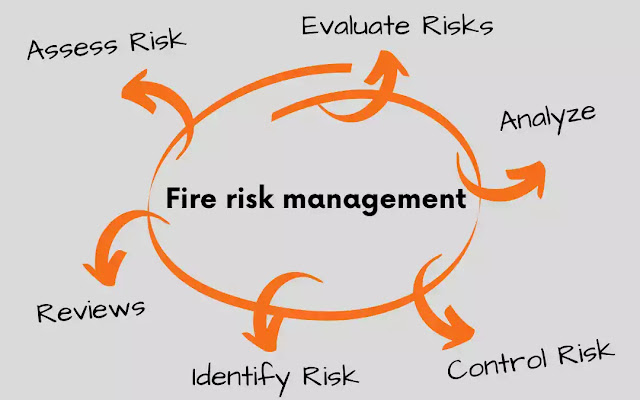Fire risk management entails systematically identifying, evaluating and mitigating potential fire hazards to decrease their likelihood and limit any subsequent damages if a blaze does break out. Its strategies fall broadly under three main headings: Prevention, Protection and Preparedness.
Fire prevention
Prevention strategies aim to remove or reduce the chances of a fire starting. This involves:- Elimination of hazards: Eliminating potential sources of fire by clearing away materials like flammable materials, combustible waste and heat sources is the best strategy for fire prevention. A clean and orderly workplace environment can eliminate many potential fire hazards.
- Control of ignition sources: Ignition sources such as electrical equipment, open flames, and hot surfaces should be controlled. This includes ensuring proper installation, maintenance, and use of equipment; enforcing no-smoking rules, and controlling activities that could create sparks or heat.
- Safe handling and storing flammable substances: Flammable or combustible materials should always be stored safely, with storage areas designed to contain fires away from ignition sources.
Fire protection
Protection strategies aim to limit the impact of a fire if it does start. This involves:
Protection strategies aim to limit the impact of a fire if it does start. This involves:
- Use of fire-resistant materials: Building materials and furnishings should incorporate fire-resistant properties in order to limit the spread of a fire, with compliance with local building codes and standards being essential. Fire resistance ratings on materials should also meet local specifications for testing purposes.
- Installation of fire suppression systems: Fire suppression systems such as sprinklers and fire extinguishers can quickly contain a fire and limit damage. They should be regularly maintained to ensure they work when needed.
- Compartmentation: This is the use of fire doors, walls, and floors to divide a building into fire-resistant compartments. This can limit the spread of a fire and provide a safe means of escape.
Fire preparedness
Preparedness strategies aim to ensure that people can respond effectively if a fire does occur. This involves:
Preparedness strategies aim to ensure that people can respond effectively if a fire does occur. This involves:
- Emergency planning: An emergency plan should include clear procedures for raising the alarm, calling the fire service, and evacuating the building. It should also assign responsibilities for these actions.
- Training: All staff should receive proper training on emergency plans, fire risks and the use of firefighting equipment. Regular fire drills should take place to make sure procedures can be implemented effectively and that staff understand them fully.
- Maintenance: Regular inspection, testing, and maintenance of fire protection systems, emergency lighting, and exit routes should be carried out to ensure that they are always in a ready state.
In short, prevention, protection, and preparedness form the cornerstone of effective fire risk management strategies. When implemented effectively these can significantly lower both the chance of fire occurring as well as its severity if one does occur.
More.........
- Learning from Fire Incidents: Case Studies
- Post-Fire Recovery and Investigation
- Fire Safety in Healthcare and Educational Institutions
- Fire Emergency Communication and Coordination
- Fire Safety Compliance and Enforcement
- Fire Risk Assessment Process
- Fire Safety Inspections and Audits
- Fire Safety Systems Integration
- Fire Suppression Systems and Equipment
- Fire Safety in Industrial and Manufacturing Facilities
- International Fire Safety Codes and Practices
- Fire Safety Measures in High-Rise Buildings
- Emergency Evacuation Planning
- Fire Detection and Alarm Systems
- Fire Investigation Techniques and Procedures
- Firefighting Techniques and Equipment
- Fire Safety Planning and Documentation
- Fire Risk Management Strategies
- Fire Safety Legislation
- Fire Prevention Strategies
- Evacuation Techniques and Strategies
- Fire Safety Roles and Responsibilities
- Emergency Response Planning and Procedures
- The Importance of Fire Safety
- Building Construction and Fire Resistance
- Importance of Fire Safety Training
- Fire Safety in Offices and Administrative Buildings
- Fire Safety in Warehouses and Storage Facilities
- Fire Safety Regulations and Standards
- Fire Science and Behavior
